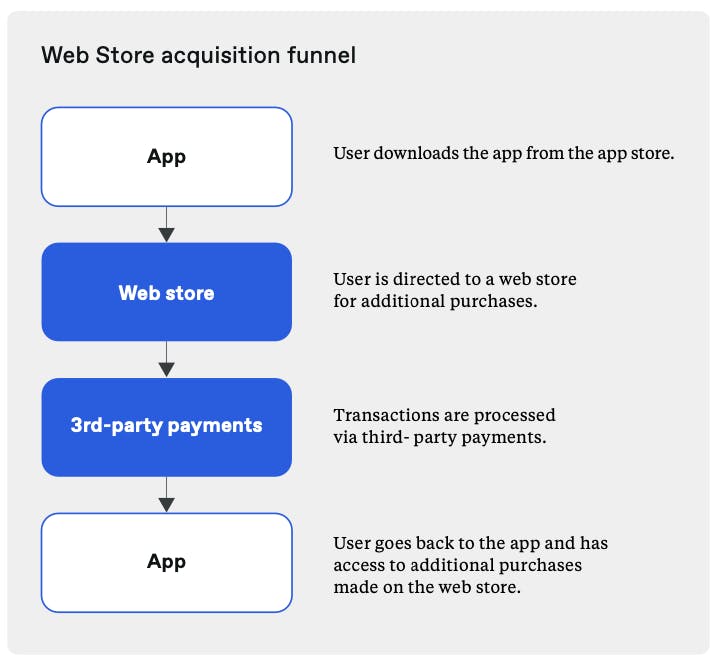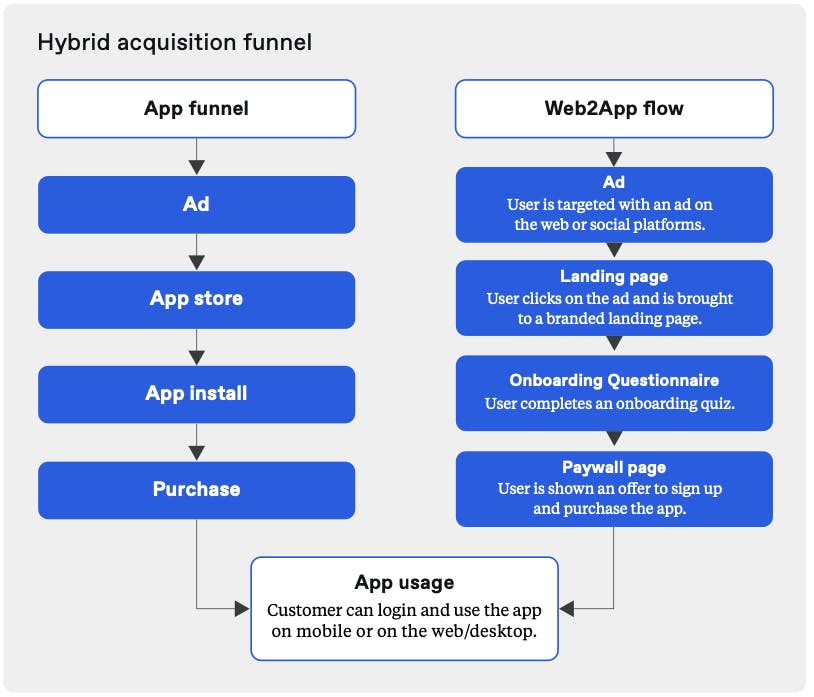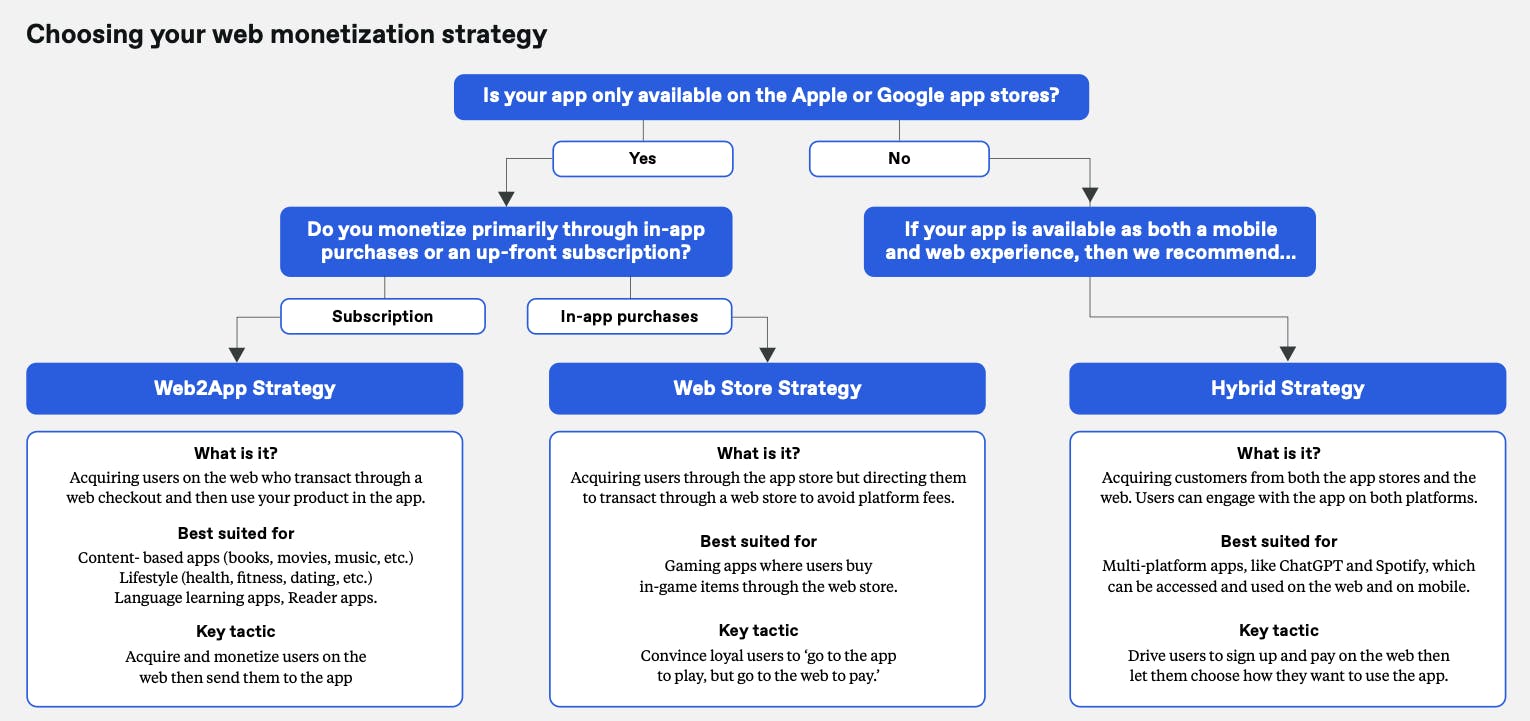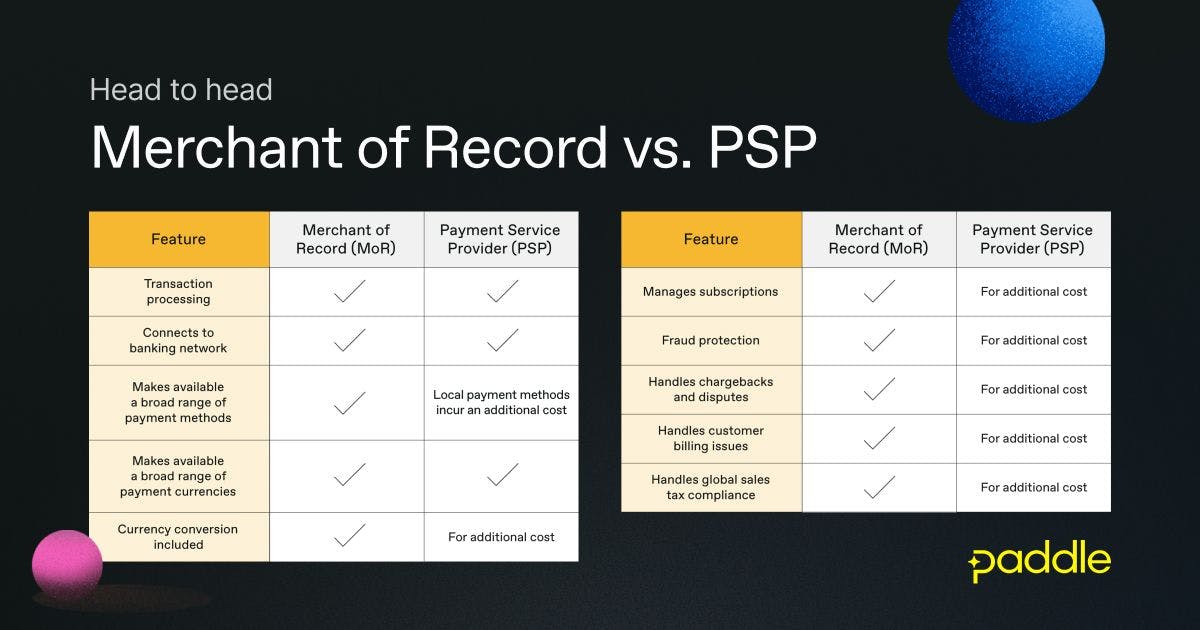The right app monetization strategies can maximize your revenue and unlock better marketing attribution. Find out which is best for you.
- The value of the app stores
- What are the benefits of monetizing your app on the web?
- Selling outside the app store - Is it right for your app?
- How to nail selling your mobile app on the web in 3 steps
- Choose the right platform to handle payment
- Examples of app companies selling outside the app store
- How to earn more with Paddle handling web payments
- Catch more revenue selling your app on the web
What does mobile app monetization mean?
Mobile app monetization is the process of generating revenue from a mobile app through various methods, such as in-app purchases, advertising, subscription plans, freemium models, or adopting a web monetization model by selling outside the app store.
Looking beyond app stores
There’s a world (wide web) of revenue beyond the app stores.
If you’re not selling your mobile app on the web, you’re giving away a share of your revenue to the biggest companies in the world.
Selling your mobile app on the web (which is within Apple and Google’s rules when done right) enables you to reach larger, global audiences and avoid platform fees, while also giving you greater flexibility over subscription, marketing and retention strategies.
But mobile app monetization on the web (which we’ve termed ‘web monetization’) also brings new challenges, such as managing international payments, driving conversions outside the familiarity of the app stores, unifying your app store and web revenue, and complying with global sales tax regulations, to name a few.
In this guide, we’ll show you how to effectively monetize your mobile app on the web and the various app monetization strategies out there, so you can earn more revenue and grow your user base.
Read on below or download the PDF here.
The value of the app stores
For the last 15 years, the Google Play and Apple App Store have dominated mobile app sales - selling millions of apps to billions of customers across hundreds of countries.
And there’s a good reason for that. The app stores provide a one-stop-shop for distributing your app to users all over the world, while handling all the complexities of payments, privacy and security. They are great platforms to launch your app and build a user base, but this also comes with strict rules and platform fees.
As the business of app development has matured, so too have the companies behind apps bringing in millions of dollars in revenue. There are now publicly-listed app companies and, with over 250 billion new app downloads and $170 billion of app spend last year, there is clear demand from consumers to download and purchase mobile apps.
All of this is driving developers to seek out opportunities to continue growing and maximizing app revenue and that has led them beyond the app stores.
Selling your mobile app on the web (which is within Apple and Google’s rules when done right) enables you to reach larger, global audiences and avoid platform fees, while also giving you greater flexibility over subscription, marketing and retention strategies.
Mobile app monetization: Why is selling on the web increasingly popular?
According to GP Bullhound, 'app stores are the largest markets in human history’ with Apple’s App Store and Google’s Play store accounting for 95% of the world’s app store market outside of China.
With 1 billion subscriptions and $87 billion of app expenditure in 2022, there are clear benefits for the 5.7 million apps currently on Google and Apple’s app platforms. But many mobile app developers are now turning to the web to bypass the following challenges.
The App Store historically has been the best way to reach consumers. However, as you scale and start to focus not on just the product, but on your business and margins, and how you market to different customer bases, the web is the next natural way to broaden your customer reach outside of the App Store.”
Eric Crowley, Partner, GP Bullhound
This clip was taken from our recent webinar with Eric Crowley, partner at GP Bullhound. Watch 'App monetization 2.0 + what’s next for consumer subscription apps' in full here.
Acquisition costs are getting higher
One of the major issues facing app developers is accurately tracking and optimizing marketing activities since the roll-out of Apple’s SKAdNetwork (SKAN).
Without tracking transparency and specific targeting, this is leading to higher acquisition costs and threatening profitability for some developers.
The biggest problem is attribution. Apple limits the amount of information you can send to the ad network so it hurts your user acquisition. In a web funnel, all these actions are happening in a browser on the web, so the platform does not control it.
You can ask your users different questions, like ‘What's your gender?’ ‘What's your age?’ If it's a fitness app. ‘What's your goal?’ The more first-party data you have on a customer, the better your marketing activities will perform.”
Vitaly Davydov, CEO & Founder, Adapty
Heavy app store fees
App stores levy an average 30% commission fee on app transactions. According to the Coalition for App Fairness, Apple makes over $15 billion a year from this ‘app store tax’ alone, enabling the Apple App Store to generate more revenue than 90% of the Fortune 500. Even recent reductions to the commission rate are counterbalanced by higher platform fees elsewhere.
For instance, in January 2024, Apple announced changes to its EU app store fees to comply with the EU’s Digital Markets Act (DMA), reducing commission to 10% and 17% according to a mobile app’s revenue. However, developers that ‘opt in’ to the new fee structure will also pay a ‘core technology fee’ of €0.50 ($0.54) for every download over one million and a 3% fee for using the App Store’s payment processing technology.
Anti-competitive rules
From stringent marketing restrictions to inflexible subscription management approaches, app stores’ rules have long been accused of limiting developers’ freedoms to promote and sell their products. Since 2020, Apple’s App Store has faced a mounting tide of regulatory investigations and lawsuits for breaching competition rules in the EU, the UK, and the United States.
For example, the EU fined Apple almost $2 billion over ‘anti-steering policies’ in March 2024, claiming Apple had “abused its dominant position in the market for music streaming apps” by preventing Spotify from communicating alternative ways to download its app outside the App Store.
Paddle's Danielle Delahunty-James and Alanna Harvey, founder of app investment firm Braavo, touch on this in the video below, click here to check out the full webinar.
The way people access the internet has largely moved to mobile devices, but Apple and Google basically control what and how gets on your phone. App developers think they should have the right to build their business on these devices without undue interference from these companies."
Gene Burrus, Global Policy Counsel, Coalition for App Fairness + former Director of Global Competition Policy, Spotify
What are the benefits of monetizing your app on the web?
While app stores provide a straightforward route to market for your app, they can also be a constraint on your revenue-generating capacity
On the flip side, monetizing your mobile app on the web opens up 5 key opportunities:
1. Reach an untapped audience:
Apple’s App Store attracts 650 million weekly visitors. Google’s Play Store claims 2.5 billion active users. But there are over 8.5 billion mobile subscriptions worldwide and selling via the web opens your app to all mobile users, not just app store customers. This wider audience is also largely untapped with only a 15% audience overlap between the web and the app stores.
2. Boost your app's lifetime value (LTV):
In 2022, the mobile game market generated $110 billion from player spending, but approximately 30% ($35 billion) was sucked up by platform fees.
By avoiding high commission rates and platform fees (and reducing your customer acquisition costs), web sales enable you to increase the lifetime value (LTV) of your mobile app.
3. Improve your marketing:
Since 2021, Apple’s IDFA has only been available upon user permission, with less than 10% of iOS users opting in. Alongside app stores’ SKAdNetwork (SKAN) restrictions, this has limited developers’ marketing scope and increased advertising (and acquisition) costs. But restriction-free marketing programs on the web provide greater clarity on campaign performance, enabling you to test ads at lower cost, analyze channel traffic more precisely, pin down purchase attribution and iterate quicker.
The App Store relies on Apple Search Ads, which is a great business to put yourself to the top of an App Store list. But then all of your competitors are there too. So what brands are looking to do is use influencers, use content, use podcasts to drive consumers to their brand on the web and convert them there, rather than going to a store that immediately has their next seven competitors listed on the shelf right next to them.”
Eric Crowley, Partner, GP Bullhound
4. Minimize churn:
According to RevenueCat’s State of Subscription Apps 2024 report, involuntary churn accounts for over 23% of lost customers on the App Store due to billing errors. On the other hand, web sales give you greater oversight of churn risks so you can implement impactful strategies for involuntary churn, such as smart payment retries and email prompts to update payment details.
5. Be more flexible:
App store rules restrict how you go to market because you don’t have the flexibility of testing different pricing options, bundling deals, or offering discounts. However, selling on the web allows you to customize subscription packages and price points to drive higher-value purchases, such as offering flexible trials or better-value term limits (i.e., annual subscriptions over monthly ones). This is especially useful if you’re looking to move from purely serving consumers to also selling B2B (i.e., adding per-seat pricing).
Anybody monetizing through in-app purchases is giving 30% of their top line revenues to Apple in perpetuity. For developers who sell their digital goods through in-app purchases, cutting out the middleman therefore has huge financial and development incentives. It’s freedom both from exploitive charges and freedom from technological limitations.”
Gene Burrus, Global Policy Counsel, Coalition for App Fairness and former Director of Global Competition Policy, Spotify
Selling outside the app store - Is it right for your app?
Companies could say, ‘Wow, I can just change my margins from 30% to 5%. Why don’t I do that automatically?’ And the answer is, it can be hard to do this successfully.
Ask any ecommerce business how hard it is to sell on the web; it’s extremely challenging. You have to acquire your customers, monetize them and get them to convert. The big thing I ask people to understand is, ‘What is the benefit you’re looking to get?’
There should be two or three benefits because selling on the web isn’t just a couple of clicks on Shopify and you’re done. It’s an entirely different marketing funnel and a whole other payment stream. You may need to hire developers. It is a big investment to do.
The way we like to think about it is once a business is approaching $30 to $50 million in revenue, then that is when it is a really interesting time to open a web store because the ROI is potentially much higher if a business moves even 10 to 15% of subscriptions to web.”
Eric Crowley, Partner, GP Bullhound
How to nail selling your mobile app on the web in 3 steps
If you’ve only sold your mobile app or game via the app stores, you’ve probably never had to think about the complexities of driving sales on the web, such as building an onboarding flow, managing international payments and ensuring users end up in your app.
But if you sell directly on the web, you need to overcome these challenges to nail your app monetization strategy.
To set up a profitable web monetization strategy, here are three steps you need to take.
1. Choose the right mobile app monetization strategy for your product
Although all web monetization strategies are fundamentally about selling on the web, not in the app store environment, there are three distinct ways you can approach web sales depending on your product. The 3 strategies we’ll explain are: Web2App, Web Store, and Hybrid.
Option 1: Web2App or Web-to-app
Also known as ‘web funnels,’ Web2App/Web-to-app involves acquiring a user on the web, who transacts through a web checkout, and then uses your product in the app.
For instance, you launch a marketing campaign through an Instagram or Facebook ad, which eventually takes the user to a paywall where they purchase and create an account, and then guides them toward the app interface to actually use your product.
Paddle's Danielle Delahunty-James breaks down the Web2App model, click here to check out the full webinar.
Best apps for Web2App:
• Lifestyle apps (health, fitness, dating etc.)
• Content-based apps (books, movies, music, etc.)
• Language learning apps
• Reader apps

Option 2: Web Store
For the Web Store strategy, you acquire the user through the app store, but they transact through your web store so you avoid the platform fees. For example,
if you’re developing a gaming app, users can’t play the game in the web store, but they can buy additional items for the game from the web store.
Many of the biggest gaming publishers have launched web stores and are incentivizing players to purchase on the web with specific promotions and discounts.
In general, the Web Store strategy involves convincing your loyal fanbase to ‘go to the app to play, but go to the web to pay’. This requires outreach with your app or gaming community, such as promising a secret VIP store for high-value items not found in the game to active high-spending players.

Option 3: Hybrid
A Hybrid strategy is best when your product offers both a web-based and mobile-based experience. In this case, you acquire customers both on the web (through marketing campaigns) and in the app (through app communication) and encourage customers to transact through a web checkout for both experiences.
For example, AI-based products, such as ChatGPT, are often available both as a web and mobile application with customers able to use the same account on both interfaces.

2. Choose the best web monetization strategy

3. Choose the right platform to handle payment
One of the app stores’ primary benefits is the billing infrastructure they provide.
They not only handle localized payments but also take care of refunds and chargebacks, all while managing sales taxes globally. But when selling directly on the web, these become your responsibility.
Sales tax compliance, in particular, can be a real headache for companies who haven’t had to manage this before. Taxes on digital products can differ between countries and even states, making it difficult to keep on top of what you owe and where.
There are two main types of payment solutions you can choose when selling on the web: a Payment Service Provider (PSP) or a Merchant of Record (MoR).
Payment Service Provider (PSP)
PSPs, such as Stripe and Checkout.com, are effectively the middlemen between your customers’ bank accounts and payment methods like Visa and Mastercard.
PSPs charge a fee for facilitating the payment transaction, but are not the legal seller and don’t support you with other financial obligations, such as chargebacks, refunds, fraud protection or handling sales tax.
In effect, PSPs are the ‘lite’ version of a payment service. They are therefore best suited to apps that are concentrated on one country or market and don’t require international payment or global tax compliance support.
Merchant of record (MoR)
A Merchant of Record (MoR), such as Paddle or Xsolla, is a legal entity responsible for selling your mobile app or game to the end customer.
As such, an MoR not only manages all your payment requirements (i.e. international transactions, currency conversions and banking connections), but also your financial liabilities, such as chargebacks and refunds, collecting and remitting sales tax, and adhering to Payment Card Industry (PCI) regulations.
The easiest way to understand an MoR is that the App Store essentially acts as one when you sell there. The big difference however is that fees are much lower and you get access to different pricing and discounting options.
An MoR is therefore better suited for apps and games that will attract customers from all over the globe.
Learn more about how Paddle helps mobile app companies successfully sell on the web

See how Paddle compares against Stripe here
3. Choose to build or buy the platforms to support this
Successfully launching a web monetization strategy requires 4 key components:
- Creating a web experience
To sell on the web, you’ll need to set up a web experience that will facilitate your strategy. If you opt for a Web Store strategy then this will mean building that store to show your products. For Web2App, you’ll need to build the onboarding flow for users to go through.
- Global-ready billing and payments infrastructure
From hosting a checkout with multiple payment methods and currencies to taking subscription payments, offering discounts, and managing chargebacks and refunds, you need a payments infrastructure that handles the complexities of global sales.
- Syncing web transactions with app subscriptions
Making sure that newly-acquired customers can easily log in and use the app. It’s also important to have all your revenue streams (web and app stores) in one place so you have a single source of truth for your app revenue.
- Ensure effective analytics measurement and tracking:
High-performing web funnels will see 20% of users reach the paywall and 1.5-2% make a purchase. But to understand how your funnel is performing and make meaningful interventions, you need to establish metric tracking.
You can either choose to build these four components internally or leverage solutions that integrate and do these for you.
Buy vs Build: Which should you do?
Building this capability in-house
Building in-house requires hiring front and back-end developers to work on getting everything set up. This can take at least 3 months depending on how much resource you can allocate to this. And you’ll need to continuously monitor and manage what you build to ensure there are no issues.
On top of this, you’ll also need to find and pay for experts to handle local taxes, exchange rates, billing, refunds and chargebacks.
Buy ready-made
Using third-party services enables you to focus more on your customer acquisition strategies and less on technical hurdles.
For instance, Web2App solution FunnelFox provides templates for web funnel optimization with an inbuilt integration to Paddle’s merchant of record payment and billing platform, which allows you to outsource your billing infrastructure, maintenance and tax compliance, and benefit from Paddle’s real-time subscription and revenue metrics.
Examples: App companies selling outside the app store
Goodnotes
Web monetization strategy: Hybrid
Goodnotes is a digital note-taking app designed for students, educators and businesses with over 24 million monthly active users spread across 144 countries.
In 2023, Goodnotes wanted to go multi- platform and sell the app in the App Store, Google Play Store and on the web. But it didn’t want to manage its own payments stack or take on the responsibility for sales tax in over 100 jurisdictions. Goodnotes decided to launch the new version of the app with Paddle as its merchant of record.
This meant it didn’t have to worry about the back-office admin of taking payments globally. It also enabled the company to introduce a B2B offering and increase revenue through more flexible payment options and subscription choices.
Having this possibility to diversify our revenue streams and reduce costs has made us even stronger as a business. With Paddle, we can better support price-sensitive students as well as other users, right around the world. That’s pretty amazing.”
Patrick Yip, Goodnotes
HubX
Web monetization strategy: Hybrid
HubX’s apps boast over 100 million users worldwide. Its Nova app turns any phone into an AI-powered assistant, DaVinci transforms words and images into stunning artwork, PhotoApp is the fastest and most powerful photo enhancer app, and PlantApp can identify over 100,000 plants with over 80% accuracy.
In early 2024, it launched its web monetization strategy. However, this brought with it a number of complexities, such as managing refunds and chargebacks, customer support on billing and payment issues, and collecting and remitting sales tax.
When we were just selling mobile apps, things were simpler as the sales tax liability was offloaded to the app stores.
Taking this on ourselves would require an upfront cost, ongoing maintenance, registration, remittance, filing, and advisory fees, along with the risk of penalties and fines depending on the jurisdiction.
This was a massive distraction for us. We wanted to be able to focus on our core business of building products and maximizing customer satisfaction.”
Kaan Ortabas, co-founder, HubX
Paddle’s Merchant of Record model immediately appealed to HubX, as well as the ability to easily add new payment methods and offer over 30 currencies, and its built-in churn prevention tools.
Since using Paddle, HubX has:
- Recovered over $100,000 in past-due payments in 72 days with Paddle Retain
- Prevented $110,000 MRR in churn by implementing cancellation flows.
- Offloaded 10,000+ billing support tickets per month
Check out the full HubX story here.
Zynga
Web monetization strategy: Web Store
Zynga is one of the world’s biggest gaming companies with a diverse portfolio of game franchises that have been downloaded more than 5 billion times on mobile. Some of the company’s most popular titles include Empires & Puzzles, FarmVille, Words With Friends, and Zynga Poker.
As the company relies on in-game purchases to drive revenue from these games, it has set up dedicated web stores for each game to retain a higher percentage of sales.
Here, players can log into their game’s web store and get access to exclusive offers on items and member rewards.
Blinkist
Web monetization strategy: Web2app
Used by over 28 million people, Blinkist finds the most relevant, impactful books and podcasts and distills them down to their key ideas, which can be read or listened to in 15-minute explainers called Blinks.
Blinkist has successfully deployed a Web2App strategy to acquire users outside the app stores.
Their funnel is built on appealing to users through engaging ads on ad networks and then directing them to an onboarding quiz on the web.
This helps Blinkist understand the user’s interests, personality, potential books they’d like, and what topics they’d like to learn more about. The answers are then collated to produce a ‘personal growth plan’.
From here, the user is prompted to sign up to see their plan before going to the paywall page which shows different plan options and discounted pricing. The customer pays on the web and is then directed to download and log in to the app to get started.
How to optimize your web revenue with Paddle
Paddle manages your payments, sales taxes, currencies, financial compliance and back office admin when selling apps and games outside the app store.
With Paddle as your merchant of record, you can boost your web revenue through better payment success, better conversions, and better retention.
Global payments infrastructure from day one
Smart payment solution
Instead of having to set up different PSPs and payment methods for different regions, Paddle’s global payments infrastructure deals with all the local payment gateways, acquiring banks and payment entities.
This smart payment solution minimizes foreign payment issues and increases payment acceptance, helping you monetize customers quicker and grow revenue globally.
Global sales tax compliance
40+ countries have introduced sales tax on digital goods and software, which applies to where your customers are based, not where you are based.
Paddle takes on all the sales tax liability for your web sales, ensuring you’re globally compliant from your first transaction in over 100 jurisdictions. As Paddle collects, files and remits sales tax for every purchase, you not only avoid financial penalties, but also the cost of tax lawyers.
Fraud monitoring and protection
According to Juniper Research, payment fraud will cost merchants an estimated $362 billion between 2023 and 2028. In addition, if your chargeback rate exceeds 1%, you’re at risk of PSPs offboarding you and freezing your funds at short notice.
But with Paddle monitoring fraud on web transactions and fighting chargebacks for you, you won’t lose out to false or fraudulent attempts to claim back revenue.
Improved payment conversions outside the app stores
Localized currencies
Selling on the web opens up your app to customers anywhere in the world - even countries that you may not be targeting. With Paddle, you can localize your entire checkout by automatically converting the language and currency to fit your customers’ region, so you maximize customer conversions and revenue in every market.
- Achieve up to 24.8% quicker growth by offering +25 currencies
Localized payment methods
Not all web customers like to transact in the same way. For instance, card payments account for 57% of US transactions, but only 16% of payments in Germany (77% prefer Paypal).
From digital wallets to country-specific payment preferences (i.e. iDEAL in the Netherlands), Paddle offers a range of payment methods, so you don’t miss out on potential revenue.
- Achieve up to 21.8% faster growth by offering at least one alternative payment method
Localized pricing
A web customer in Japan has a different willingness-to-pay than an app user in South Korea or Sweden. For instance, the Nordics are prepared to pay 28% more than your US app price, while Brazilians are prepared to pay 12% less. Paddle hyperlocalizes your web pricing to maximize your revenue intake.
- Gain up to 30% more revenue by adjusting to price sensitivity
Web stores offer huge optionality on pricing. The App Store has strict restrictions on what you can charge, but through the web, you can offer discounts, bundling, and change pricing based on customer engagement or location.”
Eric Crowley, Partner, GP Bullhound
Minimize customer churn
Smart payment retries
Paddle reduces involuntary churn with intelligent failed payment recovery and automated churn interventions.
For instance, with Paddle Retain, you can improve your failed payment recovery rate by up to 17% and recover 5-10% more by automatically sending payment recovery emails.
- Up to 17% recovery rate through improved failed payments
Term optimization
The longer a customer subscribes, the more revenue you earn. By offering quarterly and annual term plans, this not only improves your yield by up to 4x more than monthly plans, but gives you greater control of pricing measures and subscription management flows.
- 4X more LTV yield with quarterly and annual term plans
Cancellation flows & salvage offers
Implementing cancellation flows is simple with Paddle. This presents salvage offers, like pausing a subscription or switching to a different plan, when subscribers are looking to cancel and have been shown to reduce churn by up to 30%.
Catch more revenue selling your app on the web
At Paddle, we help you grow your app sales on the web, hassle-free.
- No need to deal with app stores’ fees, rules or restrictions.
- No need to build your own billing and payments infrastructure.
- No need to manage refunds, chargebacks and sales tax complexities.
See how Paddle serves mobile app companies here.
Or get in touch with one of our experts here if you’re ready to launch or optimize your web monetization strategy.




